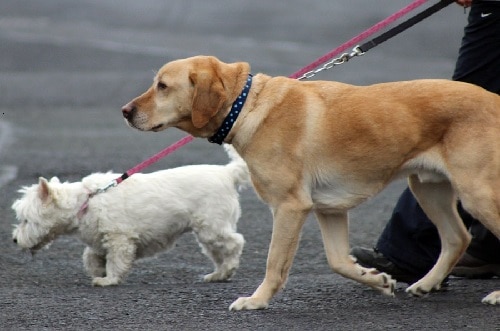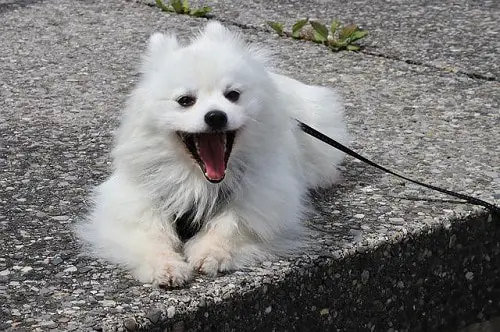Many owners of small dogs are tempted to treat them like cats, or at least they think they have fewer needs than a large dog. With many of them being 25 pounds or less, it’s easy to think of them as lap dogs. However, their size and weight aren’t necessarily proportionate to their exercise needs. So do small dogs need to be walked?
Small dogs do need to be walked. Walking is essential for your dog’s health and well-being. It’s an excellent moderate physical activity and mental stimulation for dogs regardless of their size. Regular walks also help reduce stress, spend pent-up energy, minimize behavioral issues, and prevent serious health problems.

How Exactly Do Walks Help With Behavioral Issues?
Put yourself in your dog’s shoes. As the owners, we are their only way to access the things they need. If we don’t give them opportunities to explore, then they are confined in an apartment or house. This can lead to boredom, as dogs are lively creatures who crave stimulation.
This boredom can look like them going barking at anything that passes nearby. It could also lead them to tear up furniture and shoes or become aggressive to other members of the household. Walks are an outlet for your dog to learn about the world around them, use all their senses, and get the stimulation they desire.
The Need For Exercise
All dogs need physical activity and mental stimulation – yes even your small and lazy lap dog! When a dog doesn’t have enough interesting things going on in their day, they make interesting things happen, which usually are really big messes for us to clean up. So walking your dog might be the solution to any kind of behavior problem.
Walking For Better Health
Obesity is a serious problem, especially in small dogs. They are experts at becoming couch potatoes, and because of their nature, owners tend to overlook their need to exercise. A lack of regular exercise is one of the main causes of canine obesity.
Using a physical outlet like walking allows small dogs to burn some calories, strengthen their muscles, and regulate their metabolism. All of this combined means that your tiny furball will live a longer and happier life while reducing the risk of diseases like hypertension, arthritis, and diabetes.
How Long Should You Walk Your Small Dog?
Walking a Chihuahua is going to look very different than walking a German Shepherd. Although small dogs might need shorter walks, they will still reap all of the benefits. Most of them will need at least 20 to 30 minutes of walking per day. This can be done all at once or ideally broken into multiple walks throughout the day, whichever is more convenient for you.
The ultimate goal is to make walks a fun activity for you and your dog. It’s OK to skip a walk from time to time, but following this general guideline will give your dog the best results. And if you don’t walk your dog for a day, it’s probably a good idea to find an alternative.
Safely Walking Your Small Dog
There are some basic rules when it comes to properly walk your dog. The best practice is to start walking your dog when he or she is a puppy. This will allow your dog to be exposed to various situations at a young age.
If it’s too late for that don’t worry, there are other ways to get your dog acclimated to walking regularly. Simple training techniques can change bad habits or behaviors. For example, teaching your dog “heel” or staying close to you while walking will allow you to have control and make it much more fun for everyone.
It is also important to teach your dog to ignore potential triggers, such as other people or dogs on the walk. You can use a voice cue like “leave it” when training for this behavior. Make sure to reward them with a treat when they ignore the distractions and continue to focus on you. These commands will ensure that walks are peaceful and enjoyable.
Walking Flat-Faced Dogs
If your dog is a brachycephalic breed, there are extra precautions that you need to take. Brachycephalic, or flat-faced, dogs are those with short or compressed snouts. It includes breeds, such as Pugs, Boxers, Bulldogs, French Bulldogs, and Shih Tzus.
Due to compressed airways, these dogs tend to struggle to get enough air, especially if it’s warm outside. Temperatures as low as 80 degrees can trigger breathing problems for them. Monitor them closely on walks and always provide water and breaks. If it is hot outside, forget the walk and replace it with indoor activities.
Owner’s Responsibility During Walks
The number one tip for walking is to be aware of your dog and surroundings. Always keep an eye on your small walking buddy. If there’s anything wrong, take a break and assess the situation.
You should also pay attention to traffic, potential sharp objects on the road or sidewalk, and the heat of the pavement so your dog’s paws don’t get burned. Noticing these things along with triggers like an unfamiliar dog or person can keep you and your pup safe.
Final Thoughts About Walking Small Dogs!
Every dog owner’s goal is to give their pets the happiest life possible. They are our most loyal companions, and it’s up to us to provide them with the best care we can.

Taking your little dog on walks and maintaining a consistent schedule for exercise means you can do just that. Your dog will love seeing the great outdoors and will appreciate the time you spend with them.
So Grab A Leash And Go Walk Your Small Dog!
